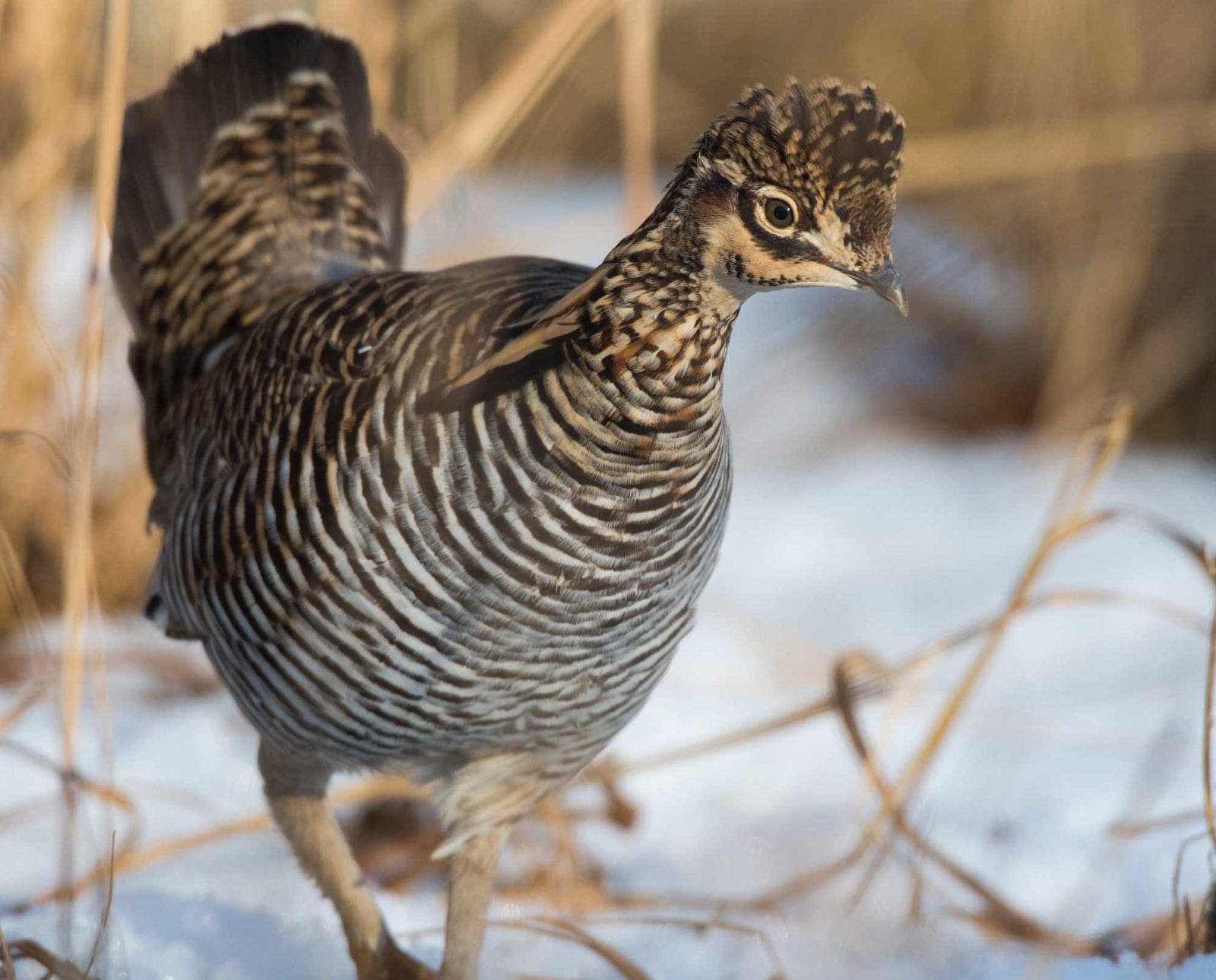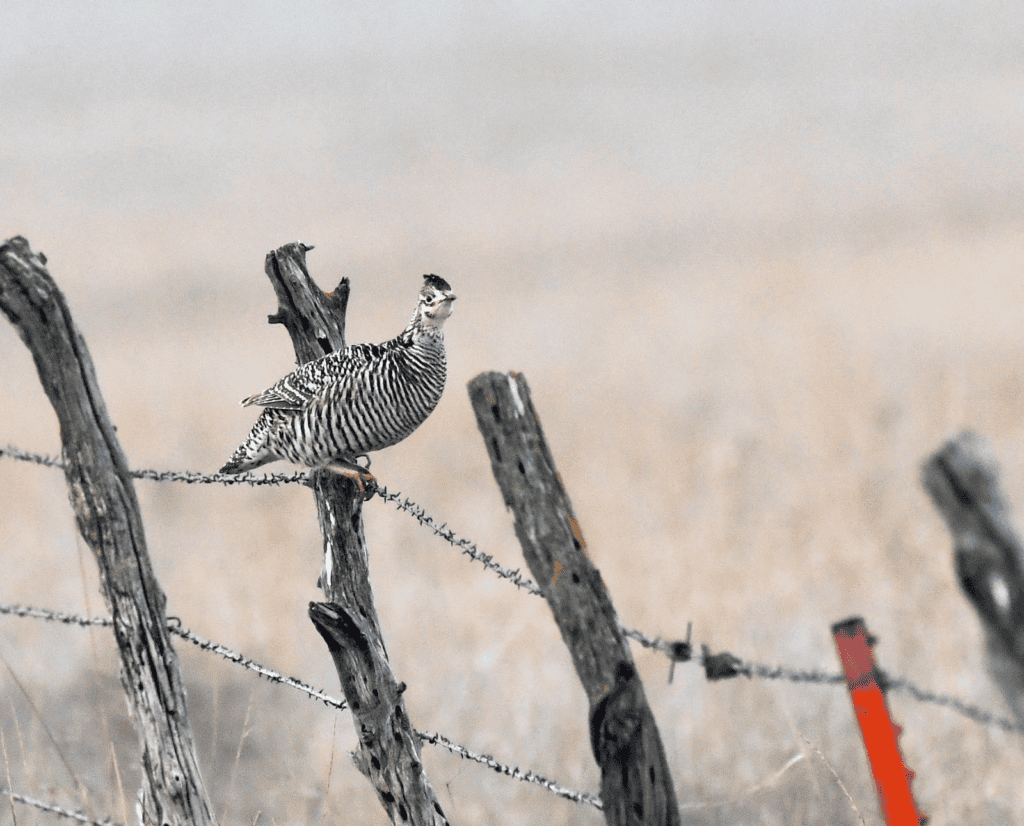Home » Grouse Species » Prairie Chicken Hunting » Hunting Late Season Prairie Chickens
Hunting Late Season Prairie Chickens

Frank Loncarich has been a wildlife biologist for over 20…
Raised in the upland bird mecca of Kansas, the passion…
Tips for hunting greater prairie-chickens towards the end of their season.
The Kansas Flint Hills prairie rose 100 feet above the low-lying soybean field I was hunting. Each day, two groups of greater prairie-chickens screamed down from the grasslands and into the field to feed at unbelievable speeds. I had these birds dialed in; I knew exactly which electric pole they flew past every morning. I was set up well before dawn, ready to pass-shoot them.
The first group came in well in advance, but I was unprepared for how fast they were. I missed, wildly behind. I adjusted my swing on the next group, got lucky, and dropped a bird at the tail end of the group. Was it the bird I was shooting at? Probably not. But in any case, I had my first late season chicken.
That chicken hunting experience was more like pass-shooting waterfowl than upland bird hunting, but it was utterly unique and incredibly fun. Every upland hunter should try it. These tips will help you connect on a greater prairie-chicken during the late season.
Greater Prairie-Chicken Winter Feeding Habits
Greater prairie-chickens are a distinct grassland species. They’re one of the most obligate grassland bird species in North America. However, they have adapted to feeding on grain crops left over after a harvest.
Like most upland bird species, they feed first thing in the morning and again in the evening. Unlike most upland birds, though, they don’t walk into their feeding grounds. Instead, they fly from their roosts and loafing areas in the grasslands to the crop fields to feed.
Their preference for flying means they can be very easy to spot going from one place to the next. This makes identifying a good hunting spot easy. My most successful scouting trips included driving around grasslands and croplands in the mornings and evenings, looking for birds flying from place to place.

Advice For Pass-Shooting Prairie Chickens
Prairie-chickens have a peculiar habit of using the same field for several consecutive days. These birds also enter the field at roughly the same place every time. Sometimes, multiple groups of birds will exhibit this behavior in one single field. It is wise to spend a couple of mornings pinpointing the precise spot where they enter and exit the field to ensure you have the best chance at a shot.
Once you have found the best spot for success, secure permission to hunt the field. If permission is granted, approach the hunt as if you were duck hunting. Wear camouflage clothing and consider grassing in a makeshift blind. Stay very still; only rise to shoot when the birds are in range.
Surprisingly, pass-shooting feels very similar to dove hunting. The birds enter the field deceptively fast, and it is easy to shoot behind them. Luckily, the same group will often return to the field in the same spot after the first volley, giving you multiple chances to dial in your lead. Also, multiple shot opportunities can occur if several flocks are using the same field.
Selecting For Adult Male Prairie-Chickens
A long-time winter prairie-chicken hunter once told me, “If you want to harvest a fully feathered male for mounting purposes, consider waiting for the second or third flock to enter the field before pulling the trigger.”
Adult males visit grassland leks every morning as a part of their social dynamic before feeding. As a result, they are often the last birds to fly into the feed fields. I’ve not hunted chickens enough during the winter to know if his advice is true, but biologically, it makes sense. If you can afford to lay off the first flock, perhaps give it some consideration.
Tips for Hunting Late Season Prairie-Chickens With A Dog
Greater prairie-chickens are hard to approach between November and January. During this time, they live in large flocks and often post sentry birds to keep an eye out for danger. They also flush from hunters and dogs at much longer distances. These habits are why several states initiated early season prairie-chicken hunts in September. In September, the birds act more like traditional upland game birds and are more easily hunted with bird dogs.
That said, traditional upland hunters can use a couple of tricks to approach late season birds. First, use terrain to your advantage. Birds often tuck into the lee side of hills or ridges to gain respite from the prairie winds. Sneak around the back side of these places and pop up over the top to catch snoozing birds unaware. This is a time-tested tactic, especially in the Sandhills of Nebraska.
Additionally, hunt with close-ranging dogs and be as quiet as possible. Loud yelling, whistling, and rangy dogs make approaching prairie-chickens even tougher, even if your dog holds a staunch point.
Lastly, it does no good to hunt taller grass. Prairie-chickens don’t use tall grasses very often. If you’re hunting traditional pheasant cover, the grass is too tall.
I don’t say all this to make killing birds during the traditional winter seasons sound impossible. It’s just harder. But it can be done. Don’t be discouraged by my warnings. Instead, use these tips to help you be successful.

Where to Hunt Late Season Prairie-Chickens
Kansas is the classic state to hunt greater prairie-chickens in grasslands and feed fields during the late season. While the Flint Hills population has struggled recently, there are still plenty of places to pass shoot birds flying into crop fields. Here, the fields tend to be in the creek bottoms below the hills, like in the story I mentioned at the beginning of this article.
Additional options include Kansas’s Smoky Hills and High Plains. These landscapes have a much greater interspersion of grasslands and croplands plus a more robust road system. Flying birds are easier to spot the morning and afternoon skies. There are also more publicly accessible grassland pieces in these sections than in the Flint Hills, so you’ll have more room for you and your dog to roam.
I’ve had good luck knocking on doors in the Flint and Smoky Hills to secure private land permission. Kansas landowners respect prairie chickens but do not prize them as highly as pheasants. Nebraska and South Dakota also have large chunks of grasslands interspersed with crop fields. Populations in these states are doing quite well.
As you can see, ample opportunities exist to try your hand at late season chickens. The traditional upland hunting method is always fun, but give the pass shooting along crop fields a try. You’ll find it a great challenge and quite sporting. But however you plan to do it, hunting these birds in the late season is worth it. Greater prairie-chickens are a true symbol of America’s grasslands and are a bird worth treasuring.
Frank Loncarich has been a wildlife biologist for over 20 years, specializing in bobwhite and grassland management. He is also a Habitat Consultant for Land and Legacy.
Raised in the upland bird mecca of Kansas, the passion for upland birds was born at a young age for Kyle Hedges. He has now spent over 25 years managing upland game habitat on public lands in Kansas and Missouri for State Conservation Agencies. He also works as a Habitat Consultant for Land and Legacy, assisting landowners across the country with improving their properties.



